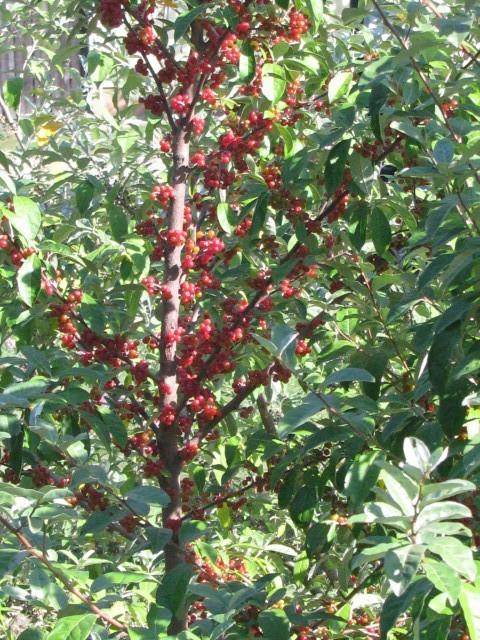
 3
3




 1
1













Idle dreamer
 1
1




 Over here we've planted some of the named cultivars - Hidden springs, Sweet and tart, Big red, Red cascade.
Over here we've planted some of the named cultivars - Hidden springs, Sweet and tart, Big red, Red cascade.
-- Wisdsom pursues me but I run faster.




 1
1






-- Wisdsom pursues me but I run faster.





Tyler Ludens wrote:Wow, folks really hate on it for being "invasive." I wonder what bad practices the plants are highlighting by "invading." Those berries are so pretty and look yummy.

The plants are relatively fast growing, tolerant of drought, saline soils, and of soil pH ranging from alkaline to acid. The roots also form a nitrogen-fixing symbiotic relationship with Frankia bacteria, similar to the relationship between legume plants and
Rhizobia. These characteristics make autumn olive particularly adapted to low-fertility loamy and sandy soils. As a result, the plants were distributed by the U.S. Soil Conservation Service and planted widely for windbreaks, and to attract wildlife.
"...specialization is for insects." - Lazarus Long
Universal Introduction to Permies
How Permies.com works













-- Wisdsom pursues me but I run faster.













Jane




Francesco Delvillani wrote:I make a very good jam with this berries....i think it's also a nice ornamental plant...
-- Wisdsom pursues me but I run faster.








Jane Reed wrote:Need one, don't know where one grows locally (western slope of Sierra Nevadas near Placerville CA), can't pay a nursery cost plus shipping which can add up to $25-30, on a Social Security income. Any help out there? Happy to pay postage for a rooted shoot. Happier to find out where I can snatch a cutting.

"People may doubt what you say, but they will believe what you do."




Jane













 Now, I'm all for fish, provided they actually are fish. See above.
Now, I'm all for fish, provided they actually are fish. See above.
-- Wisdsom pursues me but I run faster.
 1
1




"You may never know what results come of your action, but if you do nothing there will be no result”
How Permies.com Works
Be Nice





-- Wisdsom pursues me but I run faster.








-- Wisdsom pursues me but I run faster.




Crt Jakhel wrote:
Francesco Delvillani wrote:I make a very good jam with this berries....i think it's also a nice ornamental plant...
Do you not find that the jam has a partly tomato-sauce taste?
 !!
!!



Ken W Wilson wrote:
When and how do you start cuttings?
"People may doubt what you say, but they will believe what you do."
 1
1




 1
1












Marcus Billings wrote:I know this is a year old post but I thought I'd give someone the other side of the coin. The autumn olive is getting a lot of love, but in the mid-west this bush is beyond invasive. If there's one nearby, a crp field or any open area will be over run in three years with ten foot tall plants to the exclusion of all but the hardiest natives. There isn't a highway in our state that doesn't have it. And yes, they grow in the shade too. They put on foliage so fast that most forest canopies won't close up early enough or or tight enough to kill it. If used as a companion plant, it will swallow the fruit or other tree alive without very, very aggressive pruning. Unless a tree is well established, (8-12 feet tall), it will overwhelm the tree that it's next to. Put's on about 3-5 feet of growth a year in most of Indiana and after it's 15 feet tall, it just gets wider. Berries do need to be ripe to lose astringency, but I doubt you'll beat the birds to the ripe ones. Mowing regularly will slow it down and eventually kill it, but you can't stop or it comes back and I don't mow my wildlife areas and it takes over despite enormous amounts of pruning as a mulch. For a year or two, it's a great wildlife plant, but eventually gets so thick, that deer can't cross it. I would think long and hard about using it as a nitrogen fixer! There's probably something that's a better companion plant and won't takeover.
"People may doubt what you say, but they will believe what you do."




 3
3




 1
1




 1
1




A build too cool to miss:Mike's GreenhouseA great example:Joseph's Garden
All the soil info you'll ever need:
Redhawk's excellent soil-building series









steve bossie wrote:sadly our last winter killed my goumi and froze my autumn olives to the snow line. got a small bowl of berries from what survived. anyone that says autumn olive is z 3 hardy is full of it!
 5
5








Dale Hodgins wrote:The crop is slightly later this year, but definitely destined to be another Bumper Crop. That's 5 years in a row, that these bushes have produced a really good crop. Very few things are so consistent.
So far as I know I'm still the only guy who picks very many of them. On two occasions, there's been a sign put up telling people not to hog the fruit. It has to mean me. I always harvest the stuff furthest from the path, so that anyone who wants to can take all they want. The birds eat most of them.
'Theoretically this level of creeping Orwellian dynamics should ramp up our awareness, but what happens instead is that each alert becomes less and less effective because we're incredibly stupid.' - Jerry Holkins
 3
3





| I agree. Here's the link: http://stoves2.com |





